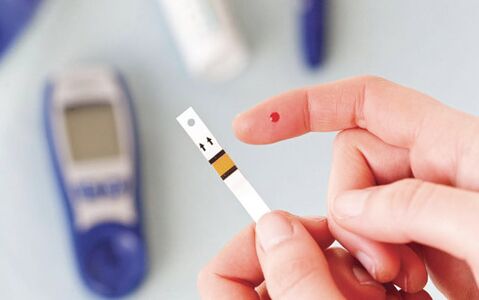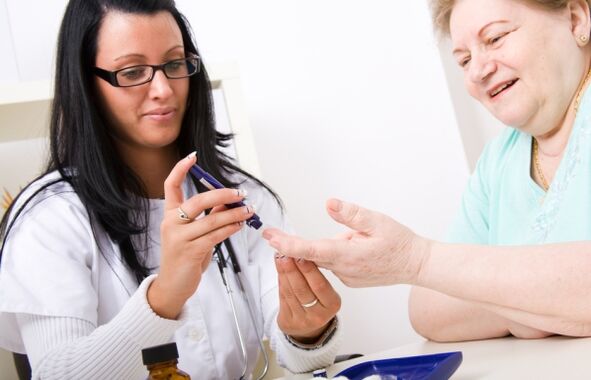Insulin - Hormonal secret processor, plays an important role, ensuring the permanence of blood glucose. Diabetes Mellitus is a consequence of the lack of this hormone. Complications caused by disease often lead to death. Basic principles of diabetes treatment are strictly adhered to diets, taking drugs or injections of insulin, blood glucose monitoring, watching your body so that you don't miss the first signs of complications.

Patogenesis of disease
Diabetes Mellitus is a persistent violation of insulin hormone synthesis and its interaction with tissues in the body.
Insulin is processing received sugar in glucose and passes through cell membranes. Therefore, the hormone descends the degree of blood sugar and delivers cell cells. Insulin deficiency with the impaired tissue sensitivity leads to the fact that glucose does not participate in metabolism and continues to circulate through the body. The biology is lost not only carbon metabolism, but also fat, protein, water salt.
Sugar growth increases the amount of lipid fractions in the bloodstream, which contributes to the development of atherosclerosis. Glucose transformation slows down in glycogen, and the body begins to use fat as resources. Thick acids are falling apart and ketone bodies that cause damage to the central nervous system.
Causes and electricity
Insulin production is disturbed due to damage to beta cell synthesization. The main risk factor for diabetes is heredity, which significantly increases the effect of other factors. The likelihood of getting sick increases with age. Causes of diabetes:
- The failure of the immune system. Causes a pancreatic cell attack with protein proteins.
- Obesity. Reduces the receptor reaction to the hormone due to excess adipose tissue (cause of type of diabetes type).
- Pancreas disease. Call the death of cells that rape hormone (pancreatitis, cancer).
- Virus infection (pathogenic chicken, rubol, flu).
- Nervous tension.
The disease exists in the role of independent pathology and as temporary symptoms. The causes of diabetes meliteness may be the consequences of the endocrine organ disabilities (hyperthyroidism, feochromocytoma). Symptomatic excess glucose detected during pregnancy (including the use of IVF) is called gestational diabetes. Hyperglycemia occurs as a side effect of the long-term use of certain medications (glucocorticoids, estrogen, psychotropic drugs), when exposed to poisonous substances.
Hyperglycemia signals diabetes only in the presence of insulin errors, the appearance of sugar disease symptoms.
Types of diabetic pathology

Diabetes Mellitus is a violation of carbohydrates and water metabolism in the body.
Classification Who determines the two leading types of diseases: insulin-conceited (and type) and opposite form - insulin-conceived diabetes (II type). They differ in the reasons for the appearance and detail of pathogenesis, the nature of the course, have their characteristics of treatment, but the consequences are like dangerous.
- Izulin-conceived (minor) diabetes caused by autoimmune body aggression. The affected endocrine beta cells are unable to produce insulin in the required doses, its permanent application is needed. People under 30 years old, thin. The disease begins suddenly, progress quickly and has a difficult course.
- Insulinon -Depetic. The causes of disease of diabetes of this type are heredity and obesity. Insulin can be produced in sufficient quantities, but cells are not sensitive to it. It is due to excess nutrients. Diabetics over 40, have complete physics. The acquired diabetes develops gradually, the layer continues. Most patients suffer from this type of disease.
Seriousness
The weight of the development of Mellitus diabetes in the glycemic phase, glucosuria, the degree of dysfunction of target bodies, is determined by the presence of complications, which shows the possibility of body compensation. There are 4 degrees of severity. If diabetes go into a slight degree, then the selected treatment and nutrition are properly selected. The degree of diabetes and symptoms is described in the table.
Characteristic diabetes symptoms

Clinical signs of disease in most cases are characterized by a gradual course.
Diabetes in adults cannot be immediately declared that this leads to the development of complications. The type and diabetes is developing rapidly with high glycemia and whom. The intensity of the symptoms of the acquired diabetes is associated with the degree of lack of insulin products, the individuality of the patient's body. You have to go through the test to determine the degree of sweet blood, if one of the symptoms appears:
- an unusual sense of dry mouth;
- Inability to drown thirst;
- Improved diureza - Increasing the presented amount of urine;
- quick weight loss or weight gain;
- Itching and dry skin;
- Reduced skin sensitivity on their feet;
- stiffness, tingling in legs and hands;
- Convulsions, the severity in their legs;
- The punctual skin processes caused by slow skin regeneration;
- Low resistance to infections;
- permanent feeling of hunger;
- vague vision;
- Increased blood pressure;
- swelling of the face and leg;
- Headache, unconsciously;
- Aceton body scent;
- darkness of consciousness;
- Pseudo -Perritritin (fake "sharp stomach").
Consequences of glycomy
Diabetes Mellitus is a sub-ranking disease. Excess blood sugar harms blood vessels, causes damage to the wall. Excess glucose is converted into deposits in fat. This leads to obesity and steatogepatosis (lipid accumulation in liver cells). Glucose causes the glycolysis of membrane proteins. The oxidative process can cause damaged functioning of proteins and the appearance of toxic per-productions. Incorrect proteins cause disruptions in the structure of the organ. The accumulation of toxins and kets causes damage to the patient's nervous system, to the disorder in the mind and whom. Excess blood cholesterol settles in arterial walls in damaged areas and forms atherosclerosis plaques, contributing to eye angiopathy, legs and other organs.
The degree of excess blood glucose levels determines the complexity of the course of the disease.
The risk of complications

Complicated diabetes Mellitus carries a risk of a sick person, so it is so important to identify the disease in time and start treatment. The disease gets worse for 10-15 years. Complications that quickly appear progress and is not easy to deal with them. Acute complications with primary diabetes (hypocriglicemia) are caused by harsh hesitations in blood sugar. List of states complicating diabetics disease:
- Hypoglycemia - a sharp decline in glucose less than 3 mmol / l can lead to a hypoglycemic coma.
- Hyperglycemia - Raising sugar indicators above 6 mmol / l ends with hyperglycemic coma.
- Ketoacidosis - Damage to neurons with ketone bodies, causing someone.
- Neuropathy - Damage to the periphery nerve.
- Diabetic feet, trophic ulcers and deadlines of lower extremities caused by angiopathy and neuropathy.
- Nephropathy - Damage to small kidney capillaries, which violates the functioning of the urinary system.
- Retinopathy - thinning the vascular walls of the retina.
- Cardiomyopathy - disorders in heart muscle.
- Encephalopathy - pathology in cerebral vessels.
Diagnostics
Diabetes diagnosis determines the type of disease, seriousness, the presence of lesions of internal organs. Studies can be implemented multiple to assess the degree of disease progress and the effect of treatment. Diagnostic criteria for diabetes are characteristic signs of diabetes and glucose raising degree. To confirm the diagnosis, urine and blood tests, instrumental studies are performed:
- indication of glucose on an empty stomach;
- Glycemic profile (daily vibrations);
- Blood at insulin level;
- Glucose tolerance study, sugar ratio on an empty stomach and after carbohydrates consumption;
- Analysis for glycolized hemoglobin;
- Blood for Biochemistry;
- General analysis of urine detection of glucose, protein;
- Electrolyte blood test;
- Aceton Urine indicators;
- Eye examination;
- Rebell Kidney damage test;
- Abdominal ultrasound;
- cardiogram for checking the function of the heart;
- Capillaryoscopy, reuroscopy of the lower extremities determine the degree of deficiencies in vessels.
In healthy people blood glucose levels range from 3, 3-5, 5 mmol / l.
Treatment treatment

In the presence of suspicion of diabetes Melitus, this diagnosis must be confirmed or rejected.
Diabetes Mellitus is a chronic pathology to be treated for a living.
Principles of diabetes treatment - sugar control in the bloodstream glucometers and prevention of complications by observing diet and taking drugs.
The endocrinologist can treat disease, cardiologist, neuropathologist, ophthalmologist, ophthalmologist, vaccular surgeon.
Modern methods of treatment - medications, diet, physical education - slow the progression of the disease.
Medications
The doctor chooses a drug, given the type of disease. Type 1 diabetes 1. Mellitus only requires insulin therapy, type 2 diabetes can be treated with sugar. The tablets operate on the pancreas, increase the sensitivity of peripheral tissues. Such medications are used:
- Sulfanilamids.
- Biguanidi.
- Insulin preparations of short and extended actions. Simple insulin is given 3-5 times a day, and long-current insulin up to 2 doses. Maybe a combined drug use.
Diet with diabetes
Diabetes treatment safely involves a nutrition with a choice of calories content, excluding easily digestible carbohydrates, sweets. Diabetes requires fractional strength. At the same time, the ratio of nutrients remains close to physiological. Sugar is replaced by xylitol or sorbitol. In the medium and heavy forms of the disease, Diet no. 9. It is allowed to eat vegetable soups, fatty species fish and meat, products of sour milk and cheese, cereals, barley oatmeals), fruits, berries of sweet and sour taste. You can never eat SDIBA, sweets, fatty dishes, rice, mashed, pasta, grapes, salty, marinated vegetables.
Prevention
The occurrence of type 1 diseases cannot always be affected, as it can cause viral pathogen. The reason for the development of type 2 diabetes is considered an unhealthy lifestyle, especially in people with hereditary prerequisites. Prevention of measure If sugar disease is diagnosed: a regular diet in small parts with minimal easily digestible carbohydrates and fat, maintaining optimal body weight. Hypertension is also controlled by blood pressure numbers. Periodically, you need to donate blood for content fractions of blood glucose and lipid. Moderate physical activity will help keep the body in a ton.























